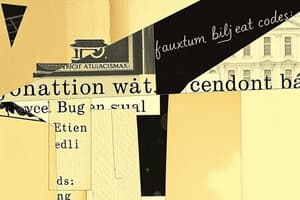Podcast
Questions and Answers
How many different languages are there in the world today?
How many different languages are there in the world today?
7,000
What allows linguists to arrange languages into groups?
What allows linguists to arrange languages into groups?
Similarities that allow linguistic arrangement based on shared features.
What is the difference between a dialect and a language?
What is the difference between a dialect and a language?
Dialect is a variation of a language; languages are considered different if there is no mutual intelligibility.
What issue arises with mutual intelligibility?
What issue arises with mutual intelligibility?
What is the border phenomenon in language?
What is the border phenomenon in language?
What are the three different approaches to language classification?
What are the three different approaches to language classification?
What does genetic classification do?
What does genetic classification do?
What is linguistic typology?
What is linguistic typology?
What does areal classification identify?
What does areal classification identify?
What is typological classification?
What is typological classification?
What are absolute universals?
What are absolute universals?
What are linguistic tendencies?
What are linguistic tendencies?
What are implicational universals?
What are implicational universals?
What are marked traits in languages?
What are marked traits in languages?
What are unmarked traits?
What are unmarked traits?
Which vowels are found in 99% of languages?
Which vowels are found in 99% of languages?
What are oral vowels?
What are oral vowels?
What are nasal vowels?
What are nasal vowels?
What is the distinction some languages make between short and long vowels?
What is the distinction some languages make between short and long vowels?
Flashcards are hidden until you start studying
Study Notes
Overview of Language Classification
- Approximately 7,000 different languages exist globally.
- Languages exhibit unique vocabulary, syntax, and sound patterns; however, similarities allow for grouping based on shared features.
Dialect vs. Language
- Dialects are variations of the same language with mutual intelligibility.
- Accents are part of dialects; if speakers cannot understand each other, they are considered different languages.
Mutual Intelligibility Challenges
- Claims of different languages may be based on historical, cultural, or religious differences rather than actual linguistic divergence.
- Chinese is often viewed as a single language despite comprising distinct languages like Mandarin and Wu.
Border Phenomenon
- Languages near borders exhibit mutual intelligibility, resulting in a blend of linguistic features from adjacent regions.
Approaches to Language Classification
- Three main classification methods: Genetic Classification, Linguistic Typology, Areal Classification.
Genetic Classification
- Organizes languages based on historical descent from a common ancestor.
- Languages may be genetically related yet differ morphologically, while unrelated languages can show structural similarities.
Linguistic Typology
- Classifies languages by structural characteristics, ignoring genetic relationships.
- Groups languages with similar sound patterns or grammatical structures and identifies linguistic universals.
Areal Classification
- Focuses on shared traits among languages in geographical proximity.
- Neighboring languages can borrow linguistic elements, leading to structural resemblance despite genetic differences.
Typological Classification
- Similar to linguistic typology, emphasizes similarities in syntactic patterns, morphological structure, and phonological systems.
Universals in Language
- Absolute universals: Structural traits appearing in all languages (e.g., presence of consonants and vowels).
- Linguistic tendencies: Patterns common to most languages, indicating structural preferences.
Implicational Universals
- Suggest that the presence of one linguistic trait indicates the presence of another, but not vice versa.
Marked vs. Unmarked Traits
- Marked traits are complex, rare, and typically acquired under specific conditions; they exhibit more variability.
- Unmarked traits are simpler, prevalent, easily acquired, and resistant to change.
Vowel Systems
- Unmarked vowels in 99% of languages include i, u, a, with e and o as common additions.
- Oral vowels are categorized as unmarked; languages can have them without nasal vowels, represented as oral vowels > nasal vowels.
- Marked nasal vowels require the presence of oral vowels; hence, languages cannot possess nasal vowels without having oral ones.
Short and Long Vowels
- Some languages differentiate between short and long vowels; however, no language consists solely of long vowels.
Studying That Suits You
Use AI to generate personalized quizzes and flashcards to suit your learning preferences.




